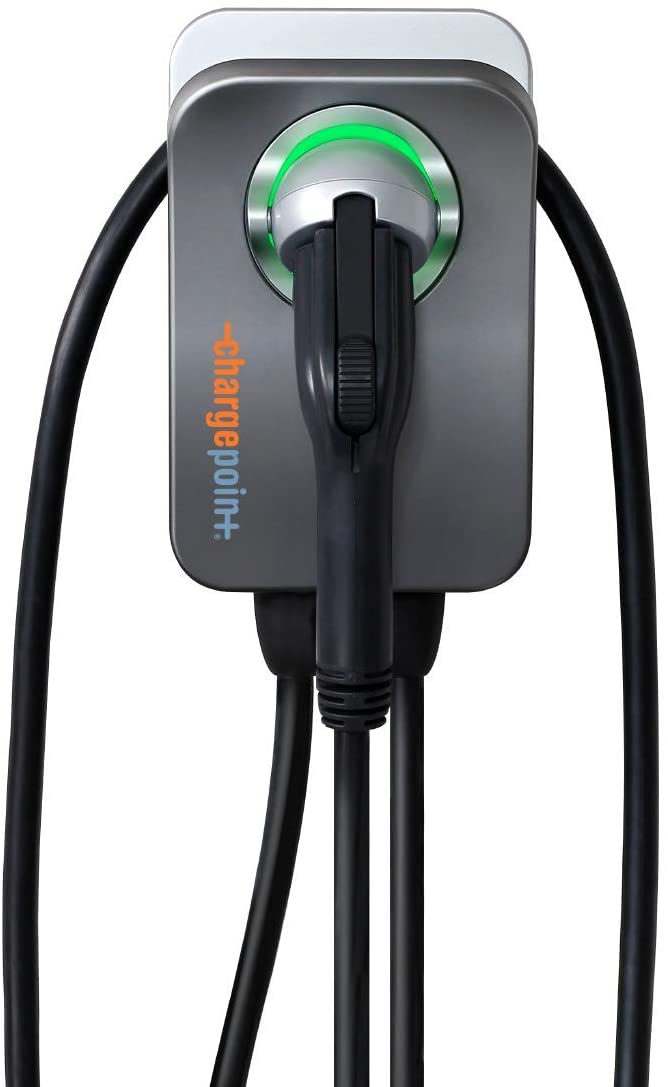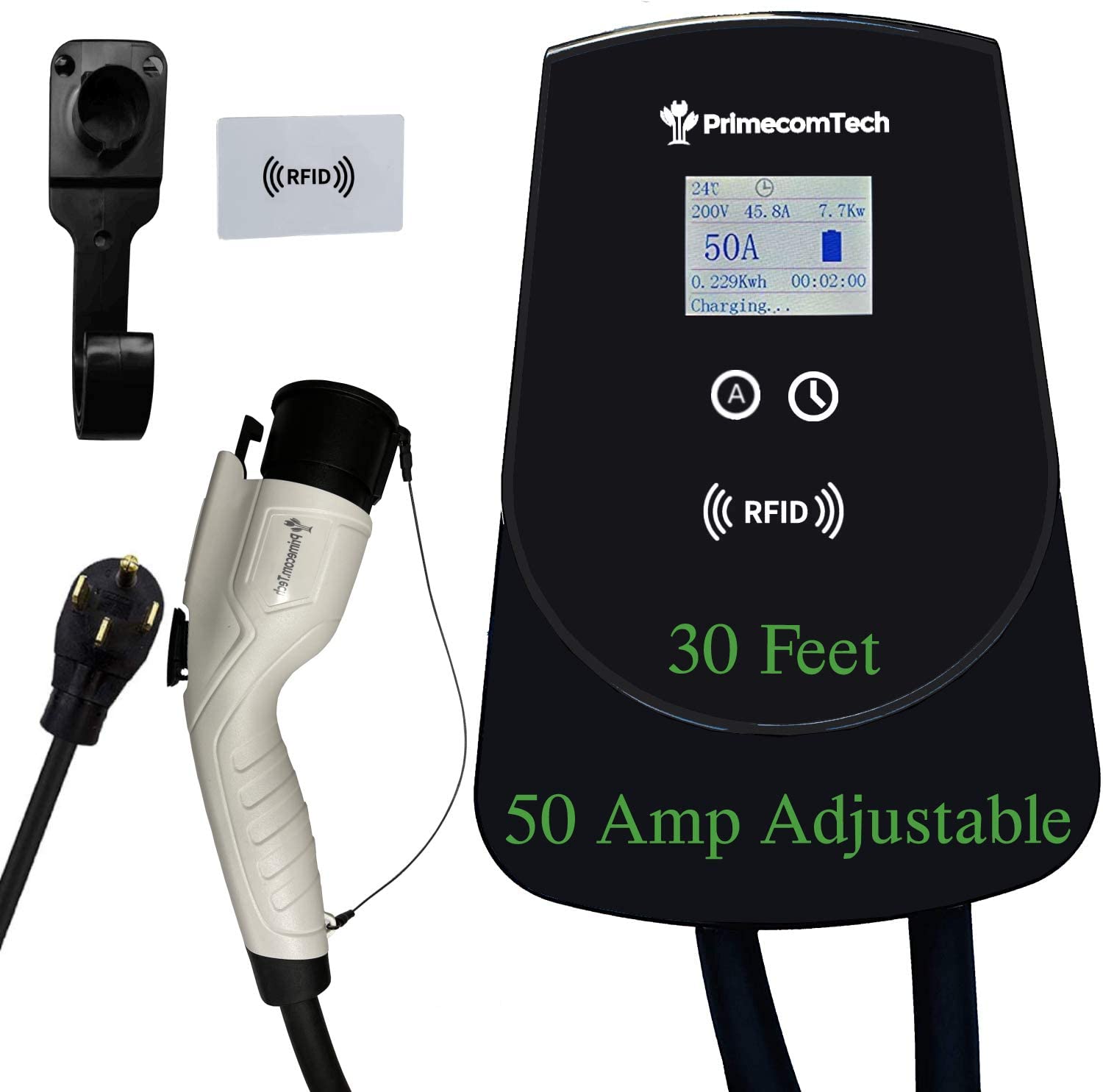We created a shortlist of 50 Amp EV Chargers that you can buy today and reviewed them based on everything from charging features to durability and connectivity features
All of these 3 chargers are guaranteed to be capable of outputting 50 Amps electrical current.
All of these 3 chargers are guaranteed to be capable of outputting 50 Amps electrical current.

| Product | Amp rating | Level | Cable Length | Nema | Power | Price |
|---|---|---|---|---|---|---|
ChargePoint Home Flex – Level 2 EV Charging Station (16-50 Amp)  | 16 – 50 Amp | Level 2 | 23 Feet (7 M) | NEMA 14-50 & NEMA 6-50 | 12 kW | Click for more info |
PRIMECOM – Level 2 EV Charging Station (50 Amp, 30 feet)  | 50 Amp | Level 2 | 30 Feet (9.1 M) | NEMA 10-50 & NEMA 14-50 | 12 kW | Click for more info |
Let’s have a look at each product in particular.
ChargePoint Home Flex – Level 2 EV Charging Station (16-50 Amp)
| Product | Amp rating | Level | Cable Length | Nema | Power | Price |
|---|---|---|---|---|---|---|
ChargePoint Home Flex – Level 2 EV Charging Station (16-50 Amp)  | 16 – 50 Amp | Level 2 | 23 Feet (7 M) | NEMA 14-50 & NEMA 6-50 | 12 kW | Click for more info |
You can plug it into either a NEMA 14-50 or a NEMA 6-50 plug but you can also hardwire it in order to get the maximum amount of power out of it. ChargePoint knows you might do that, so they even provide some stickers that you can put next to the fuse in the electrical panel, that way you’ll know who’s the troublemaker when the circuit overloads.
This comes with a 23-foot cable, which in Europe would mean 7 meters. That should be more than enough for most situations but if it is not long enough, there’s always the option of getting an extension cord. The other end of the cable uses a J1772 connector which most electric vehicles in the US use with the notable exception of Tesla models which come with an adapter.
Now this electric vehicle charging station has a 12 kW charging rate, but you probably won’t care about that as much as real life charging times, so we’ll try to estimate. Just before we do that, please note 2 things, that these are estimates based on the charger’s maximum performance and the electric car’s on-board charger which most of the time is also limited.
That being said, Tesla Model 3 from 0 to 100% in about 6-7 hours, Tesla Model Y up to 12 hours, Hyundai Kona and Kia Niro about 10 hours and the Porsche Taycan should take about 12 hours. BMW i3 with the 32 kW battery should take 4-5 hours, the Chevy Bolt EV with a 60 kWh battery would take 8-9 hours.
Then we get to the techno-geek part where the ChargePoint also shines. It has WiFi connectivity, so you can directly connect your smartphone to it and use the ChargePoint app (Same one as the one you use for public ev charging spots) to schedule charging times in order to maximize the use of cheaper off-peak electricity, find out how much money you’ve spent this month on charging the electric vehicle and get automatically notified if you arrived at home and just forgot to plug in.
On the front of this 50 Amp EV charging station, you won’t find any buttons or LCD displays, the design is fantastic and there’s a backlight on the holster that will change colors depending on the status, a very elegant way of communicating information to you without the use of an LCD screen. And since we’re on that topic, the holster of the Home Flex is one of the best because it is really easy to grip the handle, easy to mount it back and easy to find in the dark because of the backlight. The enclosure is NEMA 3R rated, so this is a charger that you install indoors. ChargePoint offers you a 3-Year warranty for every Home Flex and 24/7 customer support.
It is one of the best-selling home charging stations in the world and one of our all-time favorites.
PRIMECOM – Level 2 EV Charging Station (50 Amp, 30 feet)
| Product | Amp rating | Level | Cable Length | Nema | Power | Price |
|---|---|---|---|---|---|---|
PRIMECOM – Level 2 EV Charging Station (50 Amp, 30 feet)  | 50 Amp | Level 2 | 30 Feet (9.1 M) | NEMA 10-50 & NEMA 14-50 | 12 kW | Click for more info |
It can plug into either a NEMA 6-50, NEMA 10-50, NEMA 14-50 wall outlet, however you can also do the hardwired installation. The charging speed is essentially the same as with the ChargePoint as long as both are running at maximum capacity, there is no difference there.
The cables stretches much longer than the one on the Home Flex because this one is 30 feet long (About 9.1 meters) and it uses a J1772 connector, so you know it charges any EV.
What is also different is the fact that it is not a smart charger, there is no WiFi connectivity as this is a simple plug and play home charger. The way you interact with it is by the use of RFID cards, not the best solution but it does offer a few key features: You can change the amperage setting, prevent unauthorized charging and you can set a charging timer. The security feature is interesting indeed if you are for example mounting it in a public garage. The charging timer just delays the charging for as many hours as you want, it is not a true scheduling feature.
There is also an LCD display which tells you the amperage, voltage, the AMP level for the circuit, for example if it is a 40 Amp circuit it will most likely be limited to a 32 Amp charging rate so as not to overload it. It also tells you how many kWh have been delivered to the car since it started charging.
This unit has an enclosure which is IP56 rated, so it is certainly better suited to being installed outdoors in harsher conditions than the Home Flex but it only comes with a 1-Year No-Hassle warranty. In terms of safety features, it does come with overheat, overvoltage, overcurrent protection plus with flame resistance.
PRIMECOM also makes other portable chargers however none of them can deliver this kind of power and that many miles of range per hour to your vehicle.
Our Score
